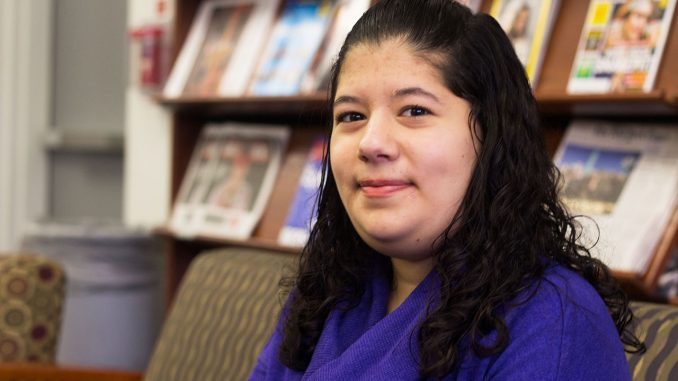
When biomedical engineer Tariq Rahman met his 5-year-old patient Joanna Costa, he developed an assistive “exoskeleton” to help her lift her arms.
More than 15 years later, Rahman still has a video of Costa eating Skittles off a table with the device.
“She was a bubbly little kid,” said Rahman, who works at Nemours/Alfred I. duPont Hospital for Children in Wilmington, Delaware. “To see her progress, it’s amazing.”
Costa, a junior accounting and Spanish major, was born with arthrogryposis multiplex congenita, which affects muscle and joint function. The disability limits the use of six of her fingers and prevents her from raising her arms above her shoulders. Her younger brother was also later diagnosed with the disorder.
After constructing wearable therapy devices for Costa for more than a decade, Rahman recently painted a watercolor portrait of her for the art exhibit “Beyond the Diagnosis,” a collection of more than 100 portraits of children living with rare diseases.
The exhibit, organized by the advocacy group Rare Diseases United Foundation, travels to different hospitals and medical schools to promote awareness of under-researched diseases.
Rare Diseases United is a Rhode Island-based outreach organization that connects parents of children with rare diseases.
From Feb. 18 to March 21, a selection of the portraits was displayed at Nemours/Alfred I. duPont Hospital for Children, where Costa has received treatment since she was a young child.
“Everybody has something, but mine’s just more visible,” Costa said. “I think these paintings kind of just remind you…it’s just another person.”
To take part in the exhibit, participants can fill out online forms to request a portrait, which are often painted by a team of volunteer artists. Rahman was the first doctor in the exhibit to paint a portrait of one of his own patients.
Before he asked Costa if she was interested in being painted, she had never heard of “Beyond the Diagnosis” and didn’t even know Rahman painted as a hobby. But she said she quickly recognized the importance of the exhibit.
“If you talk to people about kids with cancer, you get their attention right away,” Costa said. “If you say kids with rare diseases, their eyes glaze over.”
From her own interactions with able-bodied people, Costa said she thinks others can feel intimidated by her disability and struggle to know how to interact. By presenting the faces of dozens of children like her, “Beyond the Diagnosis” helps humanize a widely underrepresented group of people, she said.
“It draws attention to the kid’s face and their personality, and it’s raising awareness in a really unique way,” Costa said. “I was really honored [to be featured].”
As Rahman approached creating Costa’s portrait, he said he wanted to reflect her personality in the image. Rahman used mostly warm colors to paint her face, with dashes of blues in her cheeks for contrast.
“She’s a very courageous and accomplished young lady,” Rahman said. “I wanted to capture her character regardless of any condition she has.”
This desire to represent children who are often defined by their disabilities is part of what drove Patricia Weltin to create the exhibit.
Weltin formed Rare Disease United in 2011. At the time, Weltin said few organizations in the United States addressed all rare diseases collectively.
“I felt like our journey was the same, and it was similar enough that I could connect with anyone who had a different disease,” Weltin said.
In 2015, Weltin decided to organize a small art event including portraits of her two children, Olivia, 22, and Hana, 19, who have Ehlers-Danlos syndrome, a rarely diagnosed connective tissue disorder. The exhibit’s opening was the largest event in Rare Disease United’s history, drawing about 300 people to Brown University in the middle of a blizzard, Weltin said.
“In the beginning, we were hoping, ‘Oh, maybe we’ll get one or two medical students that might see a portrait,’” Weltin said. “And it has gone far beyond that.”
Today, Weltin said she can’t meet the demand from universities and hospitals that request to display paintings from “Beyond the Diagnosis.”
For each exhibit, the hosting institution will often devise an accompanying research project that examines a particular rare disease. All this progress in research, Weltin said, is owed to the artists.
“I could not be more grateful to the art community,” Weltin said. “They call us orphan diseases for a reason, because basically we’ve been kind of just thrown away. And the art community has adopted us.”
For Costa, participating in the exhibit has made her a role model for other children and parents. During a reception event at duPont on Feb. 20, Costa spoke about her progress with her disability and performed a song on piano.
She has played piano since she was 7 years old.
In December, Costa met with a Hungarian family who traveled to the United States to seek treatment for their 6-year-old son, Vincent, who also has arthrogryposis. The family had contacted Costa via Facebook after seeing a video of her playing piano.
“He had a lot less mobility, but he loves music,” Costa said. “He would mess with [his iPad keyboard], and he would listen to music. He had his favorite bands. You’d just see this big smile on his face.”
“I think it meant a lot to them to see that, to see me and my brother, like, ‘It’s OK,’” Costa said.


Be the first to comment